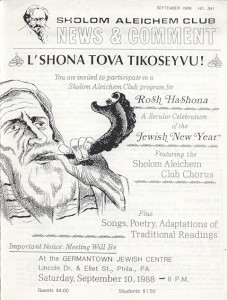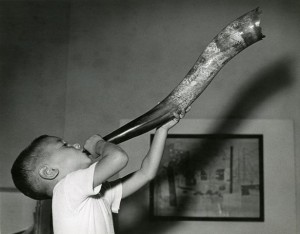Scott Ellencrig, four years old, demonstrates traditional blowing of the ram’s horn, September 21, 1960
Philadelphia Evening Bulletin Photograph Collection
The ritual blasts of the shofar marks the beginning of the Jewish New Year on Rosh Hashanah, a time of personal reflection and examination of the events of the previous year. A shofar is an instrument made from the naturally hollow horn of a ram or other kosher animal such as an antelope, gazelle, or goat. These horns are not solid bone, but contain cartilage which can be removed. The ram’s horn is traditionally used because it acts as a reminder of the Binding of Isaac in the Book of Genesis in which Abraham sacrifices a ram in place of his son. The shofar is sounded up to 100 times during synagogue services on Rosh Hashanah. The ten days of Rosh Hashanah culminate in the celebration of Yom Kippur, a day of fasting, prayer, and repentance. To mark the end of the fast on Yom Kippur, the shofar is sounded once more.
The sounding of the shofar is not limited to Jewish religious services. Secular, humanist observance of the Jewish High Holidays often time includes the blowing of the shofar to signify bringing the community together and a reaffirmation of Jewish cultural values.
 Sholom Aleichem Club News & Comment, September 1988
Sholom Aleichem Club News & Comment, September 1988
Sholom Aleichem Club Records
The First Jewish Catalog, a do-it yourself guide to Jewish life first published by the Jewish Publication Society in 1973, offers step-by-step instructions for making your own shofar:
Step 1: Boil the shofar in water for 2-5 hours. The cartilage can be pulled out with the aid of a pick. If the horn is small, this should only take half an hour.
Step 2: After the horn is completely dry, measure the length of the hollow of the shofar, cutting 1 inch further with a coping saw or hacksaw
Step 3: Drill a 1/8” hole with an electric drill from the sawed-off end until it reaches the hollow of the horn.
Step 4: With an electric modeling tool, carve a bell shaped mouthpiece similar to that of a standard trumpet. The modeling tool may also be used to carve designs on the outer edge or the body of the shofar.
Illustration by Stu Copans in The First Jewish Catalog: a Do-It-Yourself Kit
Jewish Publication Society Records
Jessica Lydon
Associate Archivist

